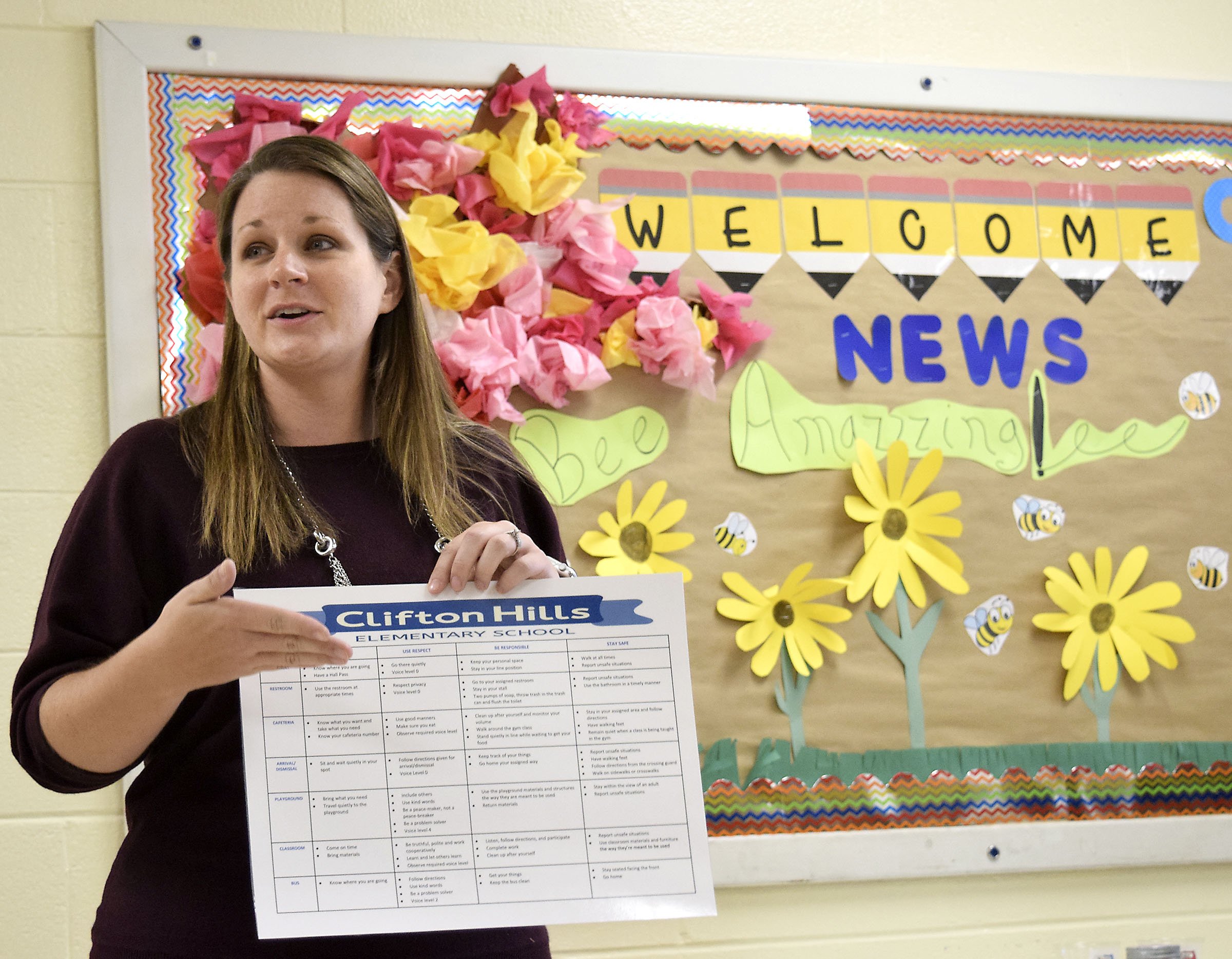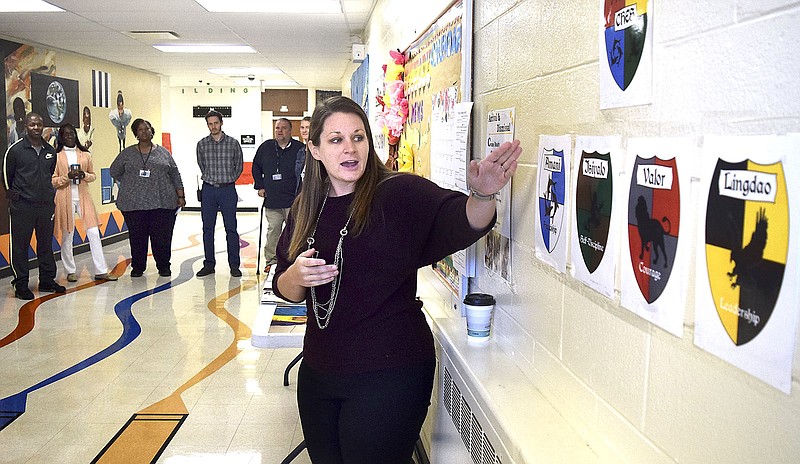"Valor" is a Spanish word for courage. "Lingdao" is a Chinese term for leader. "Amani" is a Swahili word that means peace.
These are the names of three of the four "houses" that students are sorted into at Clifton Hills Elementary School in Chattanooga.
Each house is made up of students from all grades - kindergarten through fifth - and most classrooms have a mix of students from each of the four houses.
Clifton Hills' house system is part of the school's plan for student behavior. And the strategy, known as RTI2-B, or Response to Instruction and Intervention for Behavior, is being deployed across Tennessee.
Instead of just disciplining a child when they act out, the strategy focuses on setting clear expectations and encouraging or recognizing good behavior, school leaders say.
"We came into this plan with the belief that kids want to meet your expectations, they want to make you proud, they want to be recognized," said Aaron Marvel, an assistant principal at Clifton Hills. "It's always more powerful to recognize kids when they are doing well than consistent redirection, which can sort of tear them down."
The school was recently recognized along with The Howard School by the Tennessee Department of Education and the Tennessee Behavior Supports Project out of the University of Tennessee as a model for other schools on how to implement schoolwide programs that can improve behavior and the overall school climate.
At Clifton Hills, students are encouraged to follow "C.U.B.S.," or expectations for different areas of the school or different activities. On the playground, they know to "come ready" by traveling quietly or to "use respect" by including others and using kind words. In the classroom, they might "be responsible" by ensuring they keep track of their materials, and when arriving or leaving the school, students "stay safe" by reporting any unsafe situations.
 Staff Photo by Robin Rudd/ Clifton Hills Elementary School's school counselor Kristen Light explains some of the methods the school uses to promote good behavior. The matrix, or flow chart, lays out clear expectations and consequences for problem and good behaviors. Both Clifton Hills Elementary School and The Howard School were selected as 2019-2020 Bronze Level RT12-B Model of Demonstration Schools by the Tennessee Behavior Project at the University of Tennessee and the Tennessee Department of Education.
Staff Photo by Robin Rudd/ Clifton Hills Elementary School's school counselor Kristen Light explains some of the methods the school uses to promote good behavior. The matrix, or flow chart, lays out clear expectations and consequences for problem and good behaviors. Both Clifton Hills Elementary School and The Howard School were selected as 2019-2020 Bronze Level RT12-B Model of Demonstration Schools by the Tennessee Behavior Project at the University of Tennessee and the Tennessee Department of Education.Clifton Hills Elementary School’s Houses
— Valor: House of Courage (color: red, symbol: lion)— Amani: House of Friendship (color: blue, symbol: dolphin)— Lingdao: House of Leadership (color: yellow, symbol: eagle)— Isiyalo: House of Discipline (color: green, symbol: frog)
Teachers and administrators recognize students who are modeling good behavior with tokens. At the end of the week, teachers collects each house's tokens and the school totals them. Every month, a house can win a special event like a water day or a field day. In November, the winning house will get to have a glow stick party.
"We've really tried to build up our events to bring the community in, the families in, and really to reinforce the school's positive behavior," said Kristen Light, the school counselor at Clifton Hills. "I think it's really improved the culture not only for students, but for our teachers, too. It's really like a family here."
Student behavior and a teacher's ability to manage their classroom has long been a worry of Hamilton County Schools officials and school board members.
Recently, the school board met to discuss discipline concerns after implementing a new Code of Acceptable Behavior and Discipline for students this year.
"Academic success in school and positive behavior are certainly connected and necessary for students to graduate prepared for success in a career or on a college campus," said Superintendent Bryan Johnson in a statement.
Disruptive behavior can take a toll on other students, on teachers and on the overall atmosphere of the school.
But students need to know what is expected of them, said Miller Foutch, educational consultant with the Tennessee Behavior Supports Project.
"Students don't come in with the skill sets, so they need to be taught the expectations," Foutch said.
Ideal behavior plans for schools lay out defined problem behaviors and desired behaviors, and school staff decide what is handled at the classroom level or should be handled by administration. Still, students need clear expectations with clear consequences, Foutch said.
Even at the high school level.
At The Howard School, Assistant Principal Charles Mitchell said the school's plan, The Tiger Way, is simple and consistent.
"It's an all-inclusive mindset," Mitchell said of the philosophy, which encourages Hustlin' Tiger students to be ready, be responsible and be respectful. "Everybody understands our positive expectations, and when you have those same expectations every day, they encompass all aspects of the school culture."
At Howard, teachers select a student of the month who is then entered into a schoolwide raffle. Members of the student leadership team also recognize, or praise, teachers over the school's announcements.
This makes the plan reciprocal, Mitchell said. There is buy-in from the students who are modeling ideal behaviors and it also improves teacher morale.
Howard and Clifton Hills are two of 13 Opportunity Zone schools, which are historically some of the lowest-performing schools in the county and often see higher rates of behavior problems.
At Howard, students receive incentives for behavior, as well as academics and attendance. Clifton Hills school staff are also interested in including attendance in the school's token system.
For now, when a new student arrives at Clifton Hills - which happens often due to the transient nature of the school's student population - the students in that grade level gather at some point during the new student's first few days.
In the cafeteria, students separate into their respective houses as the new student spins the "sorting wheel."
"It's a magical wheel," Light said. "It can look deep inside of you and know where your heart is."
Once the wheel lands on one of the four house colors - red, yellow, green or blue - the students of that house roar with excitement, signaling the end of the sorting ceremony.
The new student has a home.
Contact Meghan Mangrum at mmangrum@timesfreepress.com or 423-757-6592. Follow her on Twitter @memangrum.
